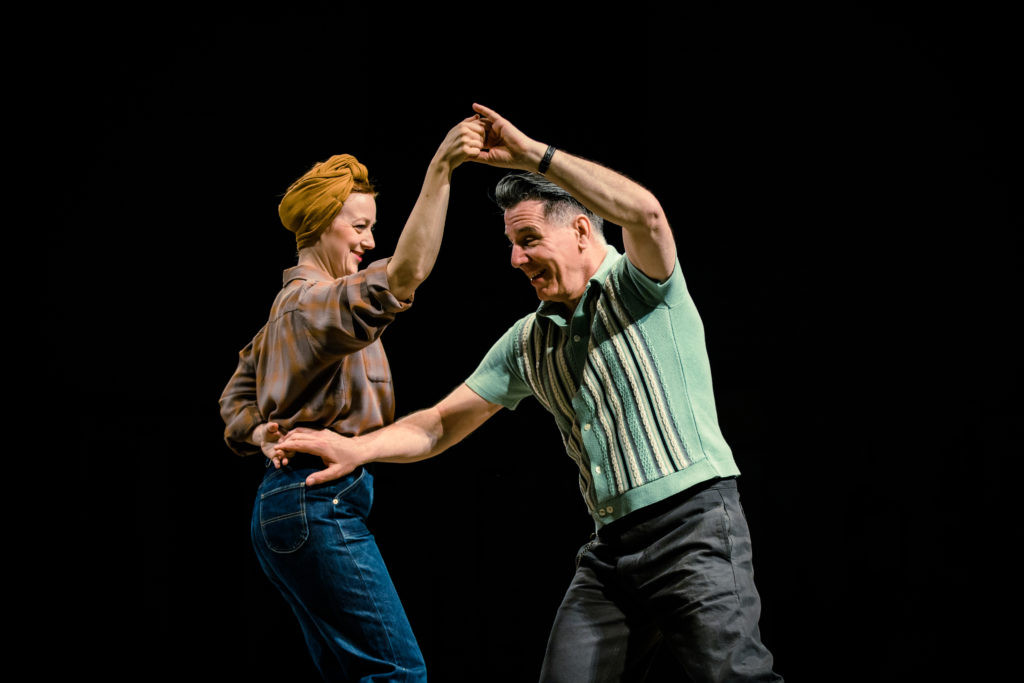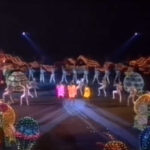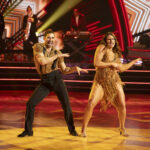The 1950s were a transformative decade, especially when it came to dance. This era marked a vibrant shift in social expression and entertainment, with dances that were as fun and groundbreaking as the decade itself. The rise of television played a pivotal role, broadcasting musical performances and, crucially, the dance steps that went along with them directly into homes across the nation. This visual medium democratized dance, making it accessible and learnable for millions.
This unprecedented exposure led to explosive popularity for certain dances. Rock’n’Roll, evolving from the energetic Jitterbug and Swing, took center stage alongside unique dances like the Madison, the Stroll, and the rhythmically engaging Hand Jive. Let’s delve into the soundtrack and the steps that defined this dynamic era of 1950s dance styles.
 Enthusiastic dancers showcase the Hand Jive, a fun and rhythmic 1950s dance style.
Enthusiastic dancers showcase the Hand Jive, a fun and rhythmic 1950s dance style.
The Soundtrack of a Generation: 1950s Music for Dancing
The 1950s were a melting pot of musical innovation, creating a rich and diverse landscape for dance. This decade witnessed rapid evolution in musical styles, most notably with the explosive arrival of Rock ‘n’ Roll. Dance trends naturally adapted and diversified to match these exciting sonic shifts. Television’s growing presence in households further accelerated the spread of new dance styles, allowing young people to learn the latest moves almost instantaneously.
-
Swing: While Swing music enjoyed its golden age in the ’30s and ’40s, the 1950s saw its influence evolve. The Big Band era, spearheaded by both Black and White musicians, began to wane. Though some bands transitioned into studio orchestras for television and radio, they largely became backing for a less swing-focused “Pop” sound. Vocalists rose to prominence, with iconic singers like Frank Sinatra, Dean Martin, and Judy Garland stepping into the limelight, signaling a shift in musical focus.
-
Jazz: Born in New Orleans at the close of the 19th century, Jazz, a genre pioneered by Buddy Bolden and fellow African-American musicians, blended ragtime, blues, and gospel with improvisational flair. Jazz remained a vital and evolving genre throughout the 20th century. The early 1950s ushered in the “Cool Jazz” phase, characterized by calmer, more relaxed melodies, perfect for a sophisticated ambiance. However, by the decade’s end, a counter-movement emerged with musicians pushing boundaries and rejecting traditional Jazz structures in favor of improvisation and experimentation, giving rise to “Free Jazz” or Avant-Garde Jazz. The 1950s Jazz scene boasted legendary figures such as Lester Young, Charlie Parker, Dizzy Gillespie, Miles Davis, John Coltrane, and the unforgettable Nina Simone.
-
Blues: Emerging from the Southern United States after the Civil War, Blues music, like Jazz, has deep African-American roots. This genre, known for its lyrical and often melancholic nature, branched into various styles, from Delta Blues to Country Blues and West Coast Blues. The 1950s marked the Blues’ entry into mainstream culture. Post-World War II migration of African Americans to urban centers like Chicago and Memphis, combined with rising incomes, helped propel the Blues from rural settings to a wider audience. Styles ranged from harmonica-driven sounds (“blues harp”) to electric guitar-based “electric blues,” with some evolving into “Rhythm & Blues.” The decade celebrated Blues icons like Muddy Waters, B.B. King, John Lee Hooker, Chuck Berry, T-Bone Walker, Howlin’ Wolf, Willie Dixon, Jimmy Reed, and Bo Diddley.
-
Rock’n’Roll: This genre was a potent fusion of musical styles – primarily Blues, Country, Bluegrass, and with hints of Jazz and Gospel. Artists like Chuck Berry, Little Richard, Jerry Lee Lewis, and, of course, Elvis Presley, “the King,” ignited a cultural phenomenon. More than just music, Rock’n’Roll in the 1950s became a lifestyle, a rebellious attitude, and a fresh perspective on the world. It impacted family dynamics, social behaviors, language, fashion, politics, and even fueled the burgeoning Civil Rights movement. Its rhythm and structure are distinct yet defy simple definition, a testament to its rich and multifaceted nature. Rock’n’Roll was truly a musical revolution that shook the nation.
-
Rockabilly: Rockabilly emerged in the Southern United States in the early 1950s, blending “Rock’n’Roll” with “hillbilly” (Country music). Often considered a Rock’n’Roll subgenre, it drew heavily from Country, Bluegrass, Jazz, Boogie Woogie, and Rhythm’n’Blues. Elvis Presley’s early recordings, along with many Sun Records artists in the early 50s, are prime examples of Rockabilly. Bands were typically small, featuring guitars and a double bass, accompanied by distinctive vocals, often with a Country “twang.” Unlike early Rock’n’Roll and Swing, Rockabilly predominantly featured white artists such as Carl Perkins, Johnny Cash, Sonny Burgess, and Jerry Lee Lewis.
-
Caribbean Craze: The 1950s also witnessed a surge in popularity for Latin American music. Mambo, Cha Cha Cha, Rumba, and Calypso rhythms permeated the airwaves, even influencing Rock’n’Roll and Pop music. The vibrant Cuban rhythms and rich musical textures were perfect for dancing, and popular artists included Pérez Prado, Tito Puente, Xavier Cugat, and Tito Rodrìgues.
Strut Your Stuff: Popular 1950s Dance Styles
Just like the music, 1950s dance styles were energetic, innovative, and full of life, reflecting the spirit of the decade. Dances ranged from lively partner styles to energetic novelty dances and engaging group formations.
Partner Dances: Twirling into Romance
Rock’n’Roll: The Energetic Embrace
“Rock’n’Roll” dance is a broad term encompassing all the dances performed to rock and roll music in the 1950s. The terminology can be quite complex, with variations existing across different states and even within ballrooms. Modern interpretations of some dance terms further complicate things. While precise definitions might vary, it’s clear that Swing dances from previous decades evolved and adapted to the new rhythms and powerful beats of Rock’n’Roll during this revolutionary era. The core of Rock’n’Roll dancing is its energetic and improvisational nature, focusing on fun and connection between partners.
Jitterbug (Jive): Fast-Paced Fun
The term “Jitterbug” originated in the 1930s, referring to both the dancer and the dance itself. It’s generally considered a simplified version of the Lindy Hop, featuring fewer steps to accommodate faster tempos. This adaptability made it a seamless transition from Swing to Rock’n’Roll music. Films like “Rock Around The Clock” and “Rock, Rock, Rock” showcased the Jitterbug to a new generation, inspiring young dancers to hit the floor and move to the infectious beats. Jitterbug is characterized by its quick steps, playful energy, and close partner connection.
Boogie Woogie: Piano-Driven Rhythms
While Boogie Woogie music gained traction in the 1920s, the dance truly flourished in the 1950s, fueled by the rise of Rock’n’Roll. Like the Jitterbug, it has roots in Swing and is another offshoot of the Lindy Hop. While perfectly suited to Boogie Woogie piano rhythms, it also became associated with high-energy, up-tempo Rock’n’Roll tunes. In the 1950s, this dance style was likely simply called “Rock’n’Roll.” However, what we now recognize as Boogie Woogie is sometimes also known as “East Coast Swing,” highlighting its lineage and smooth, yet dynamic movements.
Ready to learn some vintage moves? Explore our Dance Academy and discover the joy of 1950s dance with our expert instructors! Whether you’re a beginner or looking to refine your skills, we have something for everyone.
Calypso: Caribbean-Inspired Cha-Cha
As American culture embraced the exotic rhythms of the Caribbean in the 1950s, dances like the Mambo, Rumba, and Cha Cha Cha surged in popularity. “Chalypso” was the name coined by the influential television program “American Bandstand” for a simplified version of the Cha Cha Cha that resonated with teenagers. This partner dance retained the playful and social aspect of the Cha Cha Cha but with simpler steps performed in a looser hold, making it accessible and enjoyable for younger dancers and social settings.
Novelty Dances: Solo Sensations and Line Formations
Bunny Hop: Hop into the Party
The Bunny Hop was a quintessential early 1950s party dance. Energetic and jump-filled, yet remarkably simple and repetitive, it was ideal for social gatherings. Dancers formed a line, similar to a conga line, and executed a short sequence of side-steps and forward and backward hops to the music. The dance gained further traction through television appearances and even had its own song, some versions of which included step-by-step instructions, ensuring everyone could join the fun.
Hand Jive: Rhythm in Your Hands
In 1957, filmmaker Ken Russell captured footage of teenagers in a London coffee bar dancing the “Hand Jive.” The venue was so packed that traditional dancing was impossible. Necessity became the mother of invention, and they created a rhythmic hand-clapping choreography that could be performed without a partner, even while seated. This craze quickly crossed the Atlantic, and by 1958, American artist Johnny Otis released “Willie and the Hand Jive,” featuring a recognizable Bo-Diddley riff. The Hand Jive showcased how rhythm and fun could be expressed even in limited spaces, highlighting the creativity of 1950s dance culture.
Twist: Swivel and Shout
Another novelty dance sensation of the 1950s was the Twist. Interestingly, songs were written in response to the Twist dance craze, which was inspired by Rock’n’Roll music, rather than the other way around. In 1959, both Hank Ballard and Chubby Checker released tracks titled “The Twist” after the dance had already taken hold. The dance itself is remarkably simple: performed solo, it involves swiveling hips and ankles, creating a “grinding” motion on the floor. Torso movement is minimal, and arms often mirror the hip swiveling. The Twist’s simplicity and individualistic nature made it a massive hit, breaking down traditional dance norms.
Group Dances: Dancing in Unison
As Swing and Big Band Orchestras declined, dance halls in the 1950s faced a transitional period. However, American teenagers’ love for dance remained strong. Towards the end of the decade, group dances experienced a surge in popularity, partly fueled by television exposure. These dances offered something new and different from established partner dances. Their simple and easy-to-learn steps made them perfect for younger dancers and group participation.
The Stroll: A Line Dance with Style
The original Stroll emerged in the late 1950s, featuring lines of women facing lines of men. Couples would “stroll” down the passageway formed by the lines, dancing to the music before separating and rejoining the ends of their respective lines. “American Bandstand” broadcast the dance performed to The Diamonds’ song of the same name in 1957, catapulting it into national popularity. The Stroll, though often adapted, remains a fun and recognizable group dance enjoyed at events today.
The Madison: Calling Out the Steps
The Madison originated as a “line dance” in Ohio in the late 1950s. Danced without partners in lines across the dance floor, it follows a set choreography of steps and moves. In 1959, Ray Bryant released “It’s Madison Time,” a song that calls out the dance steps, solidifying the connection between the music and the dance. Like the Twist and the Hully Gully, the Madison gained even greater popularity in the 1960s after television exposure, becoming a staple of group dance culture.
Hully Gully: Shake and Wiggle
The precise origins of the Hully Gully are somewhat unclear. Some accounts suggest a dance called the Hully Gully existed as far back as the 1920s. However, the Hully Gully of the 1950s is generally considered an “unstructured” group dance, believed to have emerged around 1959. This timing coincides with the release of The Olympics’ song “(Baby,) Hully Gully,” which vaguely describes dance actions like “shaking” shoulders and “wiggling” knees. The Hully Gully embraced improvisation and free-form movement, encouraging dancers to express themselves within a group setting.
Conclusion: The Enduring Legacy of 1950s Dances
The music and 1950s dance styles are far from relics of the past.
Rock’n’Roll continues to thrive, and the global fascination with the rhythms, dances, fashions, and living history of this world-changing decade keeps the music and 1950s Dances vibrant and alive today. This chapter of dance history remains open, continually bringing joy to dance events and enthusiasts around the world.
Want to experience the excitement firsthand? Visit our Dance Academy to learn these iconic 1950s dances and keep the spirit of the era alive!


